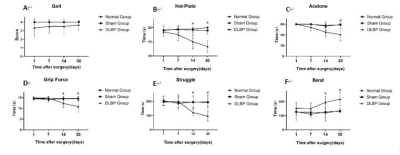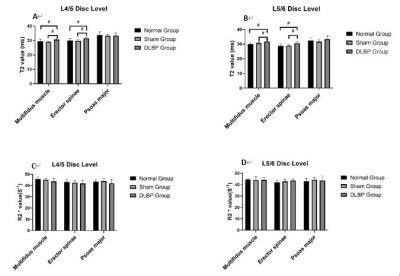Luo Bao fa1, Huang Yi long1, Yang Kai wen1, Nie Li sha2, and He Bo1
1The First Affiliated Hospital of Kunming Medical University, kunming, China, 2GE Healthcare, MR Research China, Beijing, Beijing, China
1The First Affiliated Hospital of Kunming Medical University, kunming, China, 2GE Healthcare, MR Research China, Beijing, Beijing, China
It is feasible to construct DLBP rat model by X-ray
guided puncture of intervertebral disc, and the T2 value changes earlier than
R2*in the early stage
of DLBP.

Figure.2 Behavioral assay,1,7,14 and 30 days after operation. (
A ) Gait disturbance score: There was no significant difference among the three
groups;(B and C) Hot-Plate and acetone assay: Compared with the normal group
and sham group, the DLBP group showed a decreased in pain and temperature
threshold; (D,E and F) Grip force and tail suspension assay: The DLBP group
showed reduced grip and struggle time and increased bending time due to axial
pain in the waist and back (#P < 0.05).

Figure.4 MRI T2 mapping (A and B) and BOLD (C and D),1 month
after operation. Compared with the normal group and sham group, the T2 values
of the L4/5 and L5/6 multifidus and erector spinae in the DLBP group were increased. There was no
significant difference in R2*values of multifidus , erector spinae and psoas
major among the three groups (#P < 0.05) .